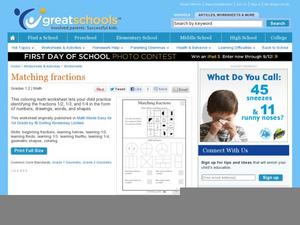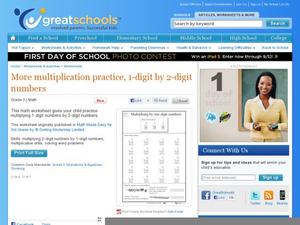Curated OER
Identifying Patterns
Although this fractions exercise may seem difficult at first, it's really quite simple and intended for beginners to mixed numbers. Scholars complete 15 number sequences by adding two or three mixed numbers or decimal numbers. However,...
Curated OER
Interpreting Circle Graphs
What does this pie chart mean? Once scholars can analyze a circle graph on a basic level (i.e. "Most people prefer cats"), it's time to delve deeper into it. They examine two graphs here, and are given the total number of participants...
Curated OER
Symmetry
Do these dotted lines indicate symmetry? Some of them do, and scholars determine which ones in 12 different images. Because some of these are tricky, it may be helpful to have large versions of these shapes printed and cut out. This way,...
Curated OER
Identify Patterns
To complete these number patterns mathematicians must determine by what number each is constantly increasing. However, this isn't your typical skip counting; scholars count by numbers like 18, 60, and even 101 to fill in the missing...
DK Publishing
Different Numbers - Ladybug's Spots
How many spots does this ladybug have? Young counters record the number. Next, they examine three ladybugs, count their spots, and circle the one that has a different number. After repeating this with another set of ladybugs, they can...
DK Publishing
Learning Place Value
A great quiz for your place-value unit! Once your first graders have mastered the 1s, 10s, and 100s place values, assess their learning with these questions. Three sections prompt pupils to provide the number in certain places, and the...
Curated OER
Symmetry
Is this the line of symmetry? Scholars analyze 12 images to determine whether or not the dotted line in each reflects symmetry. There are three examples for them to reference before they start, so consider reviewing these together before...
Curated OER
Line Graphs
Let's take a look at Luis' bike ride! Scholars examine a line graph charting a 20-kilometer bike ride over the course of six hours. They answer six questions about the data requiring the understand the concepts of each axis and the line...
Curated OER
Lines of Symmetry, Shapes and Symbols
Which shapes are symmetrical? Third graders decide which shapes have lines of symmetry, and which shapes are not symmetrical. They work on 13 shapes and symbols, four of which have lines already drawn through them. Use this resource to...
Curated OER
Long, Longer, Longest
This worm might be long, but can scholars draw an even longer worm? Focus on relative size as they draw a longer worm and then a longer necklace. Next, youngsters examine two sets of objects and check off the longest in an introduction...
Curated OER
Logic Problems
Using the number attributes they have learned, math detectives uncover the mystery number in each of these logic problems. For the three problems they examine the clues and sets of numbers, using key vocabulary such as greater than, less...
DK Publishing
Mary Sorted Her Snails
Mary needs help sorting her snails! Each snail has one of three distinct patterns on its shell, and scholars sort each into the proper category. Then, they count the number of snails in each pattern group (triangles, circles, and zigzag)...
Curated OER
The Same
Match up these silly monsters! There are six of them pictured, and young scholars match them to their identical twins. Encourage kids to explain why they made each match, focusing on specific attributes they noticed. Have them color the...
Curated OER
Match the Times
Get youngsters comfortable with telling time on both analog and digital clocks. They match times to the clock faces, all of which read a time on the hour or half-hour. The times are written out here (i.e. "half past nine" or "9...
Curated OER
The Same
Which shoes match? This is surely an activity your preschoolers do daily, so use it in an educational way. They match shoes to make pairs, connecting the matches with a line. There are eight pairs in all. Next, youngsters get to draw a...
Curated OER
Matching Fractions
Focus on halves, thirds, and fourths in these visual fraction activities. Scholars begin by examining a grid with various expressions of the three fractions displayed in the grid squares. They color-code the grid to indicate which...
Curated OER
Measurement Problems
Would you use a ruler to measure the length of a soccer field? No way! Pupils explore four tools of the trade: yardstick, measuring wheel, tape measure, and ruler. They label 12 measuring tasks with the most appropriate tool. Some of...
Curated OER
Missing Addends
Where are all the addends? Addition novices solve 36 equations by filling in the single-digit addend to achieve the given sum. They reference several examples, each of which include object sets to help learners visualize the concept....
Curated OER
Mean, Median, and Mode
Show scholars the three ways to find an average: mean, median, and mode. They reference a guided example before doing these on their own. There are three sets of data and learners find the three averages for each. All answers and data...
Curated OER
The Same
These monsters are only half-drawn! Challenge scholars to observe the line of symmetry and draw in the other half to reflect the first half. There are six simple monsters in all, and scholars can color them in once finished (encourage...
Curated OER
More Than or Less Than?
How many apples is less than five? Each of these problems has two images, one with quantifiable details and one without (i.e. a tree with apples and an empty tree). Answers will vary as young counters draw objects onto the second image...
Curated OER
More Complex Fraction Problems
If your fifth graders have mastered fractions, push them to the next level! They multiply fractions by whole numbers and decimals (in the form of money math). The worksheet provides space for pupils to write out their work, based on two...
DK Publishing
More Multiplication Practice, 1-Digit by 2-Digit Numbers
When multiplying two-digit numbers by one-digit numbers, use a guided set of problems like this one. There are three examples for young mathematicians to reference, and they solve 20 equations. They are required to regroup for some....
Curated OER
More and Less
Mental mathematicians add and subtract 1, 10, and 100 from sets of numbers. Each set of one, two and three-digit numbers gives scholars a chance to practice their addition and subtraction skills. There are 62 whole numbers in all. What...
Other popular searches
- Calculus Limits
- Pre Calculus Limits
- Limits and Continuity
- Pre Calculus With Limits
- Legal Limits
- Limits on Populations
- Functions and Limits
- Limits to Population Growth
- Limits Composite Functions
- Sexual Limits
- Constitutional Limits
- Pre Calculus Limits

























